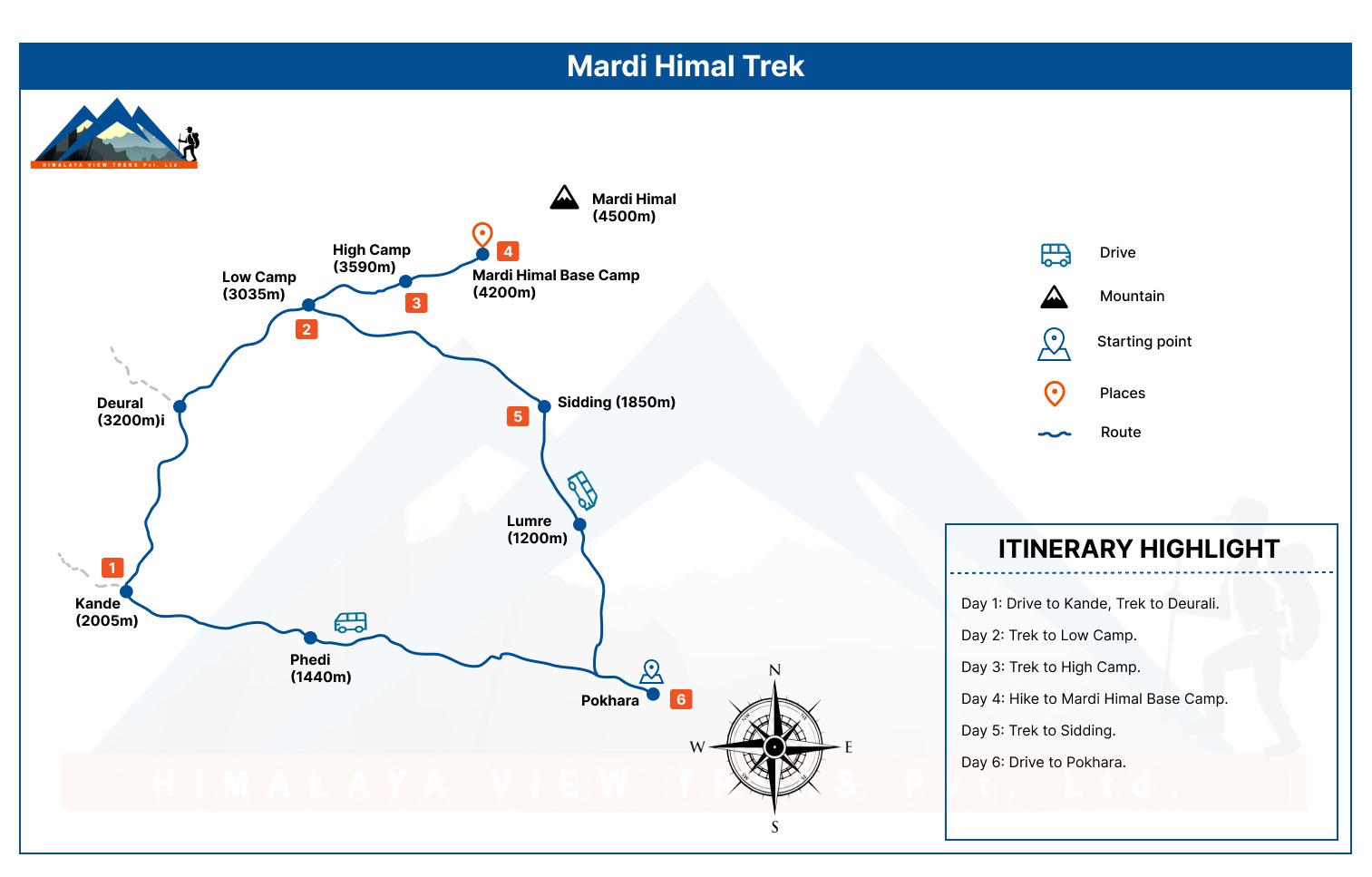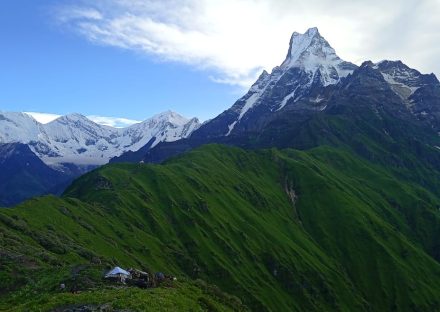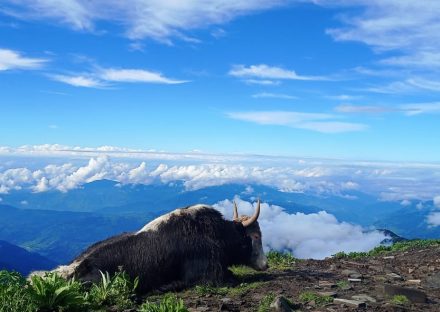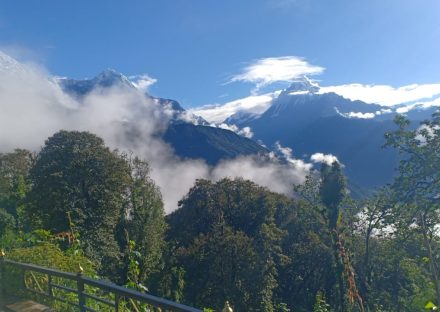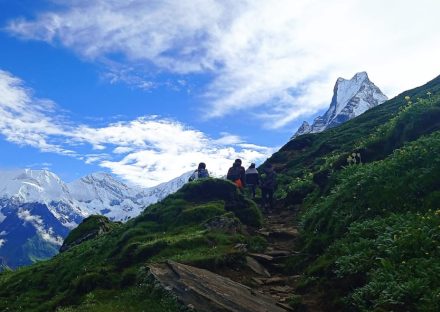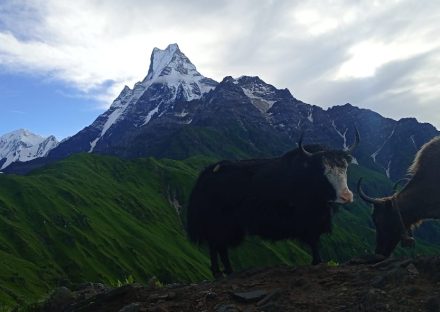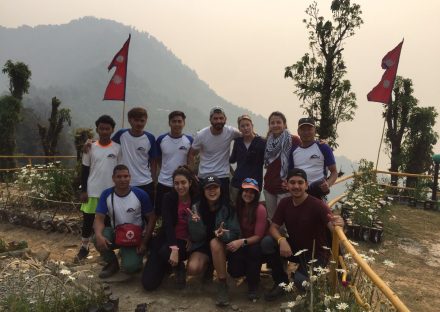- Details
- Short Itinerary
Detailed itinerary
Itinerary- Tour Includes/Excludes
- Useful Info
- Map
- Photos
- FAQ
Trip overview
Mardi Himal Trek – 5 Days Classic Route
The Mardi Himal trek is the shortest and naturally beautiful Classic route in the Annapurna region, Mardi view point is known as paradise of Annapurna. Also, Trip start from Pokhara and complete within 5 days.
The Mardi Himal trekking is an adorable option for those with limited time and a desire to travel to farther-off places in 5 Days. Travelers with limited time who want to experience the breathtaking magnificence of the Annapurna region, the Mardi Himal trip is the most fantastic choice, Which is short and simple but still provides you the authentic trekking experience as you ascend 4500 meters in just a few days, it is an excellent option for beginners getting their feet wet in the world of trekking.
However, Evergreen Mardi Himal hike is a lovely excursion with breathtaking views of the Hiunchuli, Machhapuchhre, and Annapurna peaks. The trail travels through charming towns, terraced farms, and rhododendron forests, showcasing the region’s rich cultural heritage. You’ll pass past snow-capped mountains, glaciers, and moraines that stand in striking contrast to the lush vegetation below them.
Mardi Himal Trek is one of the most beautiful adventures in the Annapurna Region!
An extraordinary journey is the Mardi Himal Base Camp Trek. It provides a unique opportunity to go to remote, unspoiled areas of the Himalayas. The walk is manageable for both expert and inexperienced hikers. Steep climbs and descents, meandering paths, and rocky terrain are problematic, but the beautiful views at the top make it all worthwhile.
The trek begins in Pokhara, a popular tourist destination known for its serene lakes and beautiful mountain views. From this point on, your journey through the lush woodlands of the area will begin. The route passes through historic villages, giving you a glimpse into local life. You will also be able to visit surrounding temples and monasteries, which offer a unique cultural experience.
However, The highlight of the Mardi Himal Treks is the view of the Annapurna range from the Base Camp. At a height of 4500 meters, the base camp has a luxurious atmosphere. Along with the clear skies, the renowned Annapurna South, Machhapucchre (Fishtail), and Hiuchuli can all be viewed in splendor.
Along the journey, you’ll see a variety of creatures, including Himalayan Thar, Himalayan Black Bear, and several bird species. The excursion is a great way to experience the regional cuisine, with a range of traditional Nepali cuisines in nearby teahouses.
Hike to Mardi upper view Point (Mardi Himal Base Camp) & Enjoy with incredible Mountain Views of Annapurna range
Moreover, From High Camp (3,580m) you can climb to Mardi Himal Upper View point (Mardi Himal Base Camp) for around 3–4 hours, which offers stunning close-up views of the entire Annapurna Range. Approximately two hours from High Camp, one of the Mardi Himal trek’s most alluring hidden secrets, lies a breathtaking viewpoint.
While on this walk, you might come across some stone huts, magnificent teahouses, and several rock cairns. As a result, it is a well-liked substitution for treks in the vicinity of Annapurna, like AC and ABC Trek.
You will always remember your walk up the Mardi Himal. The hike represents the Himalayas’ splendor, spectacular views, diverse topography, and illustrious cultural history. If you want to escape city life or take on a new adventure, Mardi Himal Trek is a fantastic option. Schedule your trek as soon as possible to go on a once-in-a-lifetime experience!, The Mardi route is the Evergreen trekking train in Annapurna region of Nepal.
Short Itinerary
Mardi Himal Trek - 5 Day Itinerary
Day 01: Drive to Kande From Pokhara then trek to Deurali via Australian Camp 4/5 hours walk, 2005m. Stay overnight at the tea house.
Day 02: Trek from Deurali to Low Camp 6/7 hours walk, 2985m. Stay overnight at the tea house.
Day 03: Trek from Low Camp to High Camp 4/5 hours walk, 3550m. Stay overnight at the tea house.
Day 04: Hike to Mardi Upper View point (Mardi Himal Base Camp 4500m.) And back to High Camp 6/7 hours walk, Stay overnight at the tea house.
Day 05: Trek to siding 4/5 hours walk, and then drive to Pokhara for about 3 hours. And then goodbye to your guide and porter in Pokhara after you get Pokhara.
Detailed Itinerary
Day 1: Drive to Kande From Pokhara, Trek to Deurali via Australian Camp (2005m)
Your tour starts with a lovely drive from Pokhara to Kande, which provides beautiful views of the Pokhara Valley and the Annapurna Mountains. You will begin your trip towards Deurali via Australian Camp after you arrive in Kande. The first part of the walk takes about four to five hours.
As you travel the trail, you'll pass through verdant forests, terraced fields, and lovely villages. The beautiful Annapurna range is first visible from the Australian Camp.
Arrive in Deurali and spend the night at a tea house there, surrounded by the peace of the Himalayan foothills.
Day 2: Trek from Deurali to Low Camp (2985m)
As you start your day in the crisp mountain air, continue to Low Camp. Today, the journey takes between 6 and 7 hours. As you climb, the forest progressively becomes less dense, and you're met with more expansive vistas of the mountains in the area.
In comparison to Deurali, Low Camp is located in a more tranquil setting. Rest up for a while, then spend the night at a tea house.
Day 3: Trek from Low Camp to High Camp (3550m)
Your hike today will take roughly four to five hours to travel from Low Camp to High Camp. As you get closer to High Camp, the terrain gets steeper, and the scenery changes to forests and alpine meadows.
Your destination for the day is High Camp, which offers the ideal atmosphere for acclimatization and relaxation. You're going to a tea house to sleep the night.
Day 4: Hike to Mardi Himal Base Camp (4500m) and Return to High Camp
Walking to the Mardi Himal Base Camp, which is at a height of 4500 meters, is an exciting day. The arduous ascent will require a round-trip time of 6 to 7 hours.
As you approach the base camp, the terrain turns rocky and steep. Awe-inspiring panoramic vistas of the Annapurna Massif and the recognizable Machhapuchhre (Fishtail) summit await you there. You'll return to High Camp for a well-earned rest after taking in the mesmerizing panoramas and outstanding pictures.
Day 5: Trek to Siding and Drive to Pokhara
Leaving the High Camp, walk 4 to 5 hours downhill to Siding, a lower elevation. You'll board a car in Siding and return to Pokhara for three hours. Your excellent Mardi Himal Trek ends when you arrive in Pokhara and bid your guide and porter farewell.
Included
- Pokhara to Kande and Siddding to Pokhara by private car/van/bus depend on group sizes
- All meals (Breakfast, lunch, and dinner) during your Mardi Himal Trek with 5 nights Hotel Accommodation.
- ACAP permit and TIM’s card permit
- Government licensed holder, fluent English Speaking familiar Guide
- One assistant guide if Group sizes is more than 10 trekkers)
- Strong local Porters for Carry trekker’s luggage One porter every 2 trekkers
- Guide and porter wages including their meals, accommodation, and Salary
- Staff insurance including medication coverage
- Equipment for the Company staff
- Water purification drop or tablets for safe drinking water
- Seasonal fresh fruits every day during Mardi Himal Trek
- Oximeter to measure Pulse and oxygen level
- Company T-shirt as a Souvenirs, and duffle bag if needed
- Local government, taxes, including official Service Charge
- Trip completion Certificate
Not Included
- Hotel accommodation and Meals in Kathmandu and Pokhara.
- Personal expense (shopping, snacks, boil bottle water, hot (tea,
- Personal expense (shopping, snacks, boil bottle water, hot (tea, coffee) and cold drinks, hot shower, alcohol, Wi-Fi, telephone call, battery charge fee during the Mardi Himal Trek)
- Personal clothing and trekking gear
- Personal travel insurance including evacuation coverage (compulsory) up to 6000m)
- Additional costs if delays flights and outside the itinerary
- All the costs and expenses which are not mentioned in includes list.
- Tips for guide and porters. in end of the treks
Useful Info
Mardi Himal Trek - Highlights:
- The Mardi Himal Trek offers beautiful hikes through lush woods, alpine meadows, and spectacular mountain vistas.
- Discover the untapped beauty of the Annapurna region with breathtaking vistas of the Annapurna range, Machhapuchhre, and Hiunchuli peaks. Take on the rugged terrain and different pictures, which provide the ideal harmony of adrenaline and peace.
- Discover the local culture as you pass through charming villages and encounter friendly locals.
- Explore the pristine Mardi Himal Base Camp while taking in the panoramic views from the High Camp;
- Examine the stunning mountain vistas from numerous angles to thoroughly grasp the Annapurna range.
- Visit one of the quaint and charming teahouses to sip a delicious cup of tea while mingling with the locals.
- You'll wake up to breathtaking mountain sunrises, and the day will end with a beautiful sunset over the valley.
- Off-the-Beaten-Path Adventure
- Interact with local Gurung and Magar communities along the trail to learn about their distinctive customs, way of life, and kind hospitality.
Equipment for Mardi Himal Trekking
This section is intended to provide information on clothing and equipment requirements for Nepal Trek. It is not intended to be a final and authoritative checklist. For those who would like a more detailed discussion of these issues, we ask you to contact us at singbir@yahoo.com or via WhatsApp at +9779841146306
The following is a list of clothing and accessories that we recommend that you take with you. This is not intended to be a comprehensive clothing and equipment list, rather it is intended to act as a reminder of those items that we feel are essential for your comfort and convenience. However, we recommend that you may have your own personal preferences for clothing which may be equally as suitable.
Footwear: Equipment for Nepal Trek
- Walking boots with suitable ankle support that have been worn in prior to the trek, and which are waterproof
- Trainer or casual shoes, for trekking and/or traveling
- Warm socks for colder areas
- Gaiters, in case of rain or snow
Legwear
- Loose, casual trousers for trekking
- Thermal leggings for colder areas
- Long skirts for women as an alternative to trousers
- Waterproof trousers
Body
- Selection of T-shirts, and long-sleeved shirts, preferably not cotton
- Thermal shirt for colder areas
- Warm shirt, possibly fleece, for colder areas
- Fleece jacket or warm wool jumper
- Windproof, waterproof outer shell garment for higher altitudes
- Down jacket (optional for cold nights & mornings; can be hired in Kathmandu cheaply)
Head / Hands
- Wool or fleece hat, or balaclava
- Hat or cap for sun protection while trekking
- Sunglasses or goggles
- Warm gloves
Other Items
- Strong rucksack or large hold all to be carried by porters
- Day sack to be carried personally
- Plastic bags or stuff sacks to store/separate trekking gear inside your main bag
- One-liter water bottle
- Personal first aid kit to include essential items
- Sleeping bag, 4 season
- Torch, ideally head torch
- Camera and film! – For those not-to-be-forgotten shots of the Himalayas
- Toilet items and towel
- Large handkerchief/bandana for neck
Optional Items
- Binoculars
- Books (see Recommended Reading)
- Altimeter
- Compass
- Playing cards/backgammon/chess set
Acute Mountain Sickness (AMS)
Altitude sickness, often known as Acute Mountain Sickness (AMS) is a particularly important medical consideration while trekking in Nepal. Altitude Mountain sickness means the effect of altitude on those who ascend too rapidly to elevations above 3000 meters. The initial symptoms of AMS are as follows:
- Nausea, vomiting
- Loss of appetite
- Sleeplessness/ Insomnia
- Persistent headache
- Dizziness, lightheadedness, confusion
- Disorientation, drunken gait
- Weakness, fatigue, lassitude, heavy legs
- Slight swelling of hands and face
- Breathlessness and Breathing irregularity
- Reduced urine output
These symptoms are to be taken very seriously. In case of an appearance of any of the above symptoms any further ascent should be avoided otherwise more serious, even life-threatening problems can happen. The only cure for Altitude Sickness is to descend to lower elevations immediately. Acclimatization by ascending to no more than 300 to 500 meters per day above 3000 meters, and the proper amount of rest and dehydrations are the best methods for the prevention of AMS.
If you follow the simple advice of your trained guide, you won’t have to worry about complications from mountain sickness. We design our tours to ensure clients are ready for high altitudes and arrange alternative Itineraries for those at risk.
Thanking you we can arrange the best trek without the risk of altitude sickness.
Although trekking in Nepal can be organized throughout the year, September through May is considered to be the best month for trekking. Summer months of the year which coincide with monsoon begin in mid-June and drains in mid-September making travel wet and warm. The mountain views may not be at their best as rain clouds and haze overhang the mountains occasionally obscure the enchanting views. These times are blessed for the keen botanist as the higher valleys and meadows blossom with flowers and lush vegetation. Get the best Nepal Trekking Information with HVT.
During monsoon, it does not mean that it will rain every day. Besides, some of the most frequented trails will not be crowded, and some people like it that way. It can actually be enjoyed in the upper part of the Annapurna circuit around Marfa, Jomsom, and Muktinath as the monsoon does not get in this trans- Himalayan area because they fall into a rain shadow area. Note: – It is recommended to carry insect repellent when trekking during the summer months.
Mardi Himal trek in the Spring season:
The Mardi Himal Trek, typically lasting from March through May, will provide a breathtaking springtime experience. When the weather is clear and temperate, spectacular views of the peaks and valleys are possible. It's the finest time of day for touring and shooting pictures because the sky is usually straightforward.
Another lovely experience is witnessing the local environment come to life in the spring when wildflowers bloom, and new growth appears in the forests. The springtime makes the walk even more beautiful, enhancing its vibrancy and beauty. The trails are also in good shape, with little mud and rain during the spring.
The rivers and streams also provide an excellent source of refreshing water during the walk. Although the days are warm and cozy, the evenings could turn chilly, so it's essential to carry layers of clothing for the changing climate. It's a great time to go hiking because neither excessive cold nor heat will be an issue. Last but not least, springtime trekking in the Mardi Himal region is a magical experience, with pleasant temperatures, clear skies, and breathtaking views of the nearby hills and valleys. The mild temperatures and beautiful skies, which offer spectacular views of the mountain tops, help to make the walk more enjoyable.
Mardi Himal trek in the Autumn season:
The autumn, when the weather is pleasant and the skies are bright, is another popular time of year for the Mardi Himal trek. The location's natural beauty, accentuated by the brilliant autumn foliage, is fantastic. The weather is crisp and clear throughout this time, giving you unhindered views of the stunning peaks and lush valleys surrounding the ascent. Due to the typically clear skies, autumn provides endless opportunities to capture the magnificence of the surroundings.
The trails are in good condition in the autumn, with less dirt and rain. The hike is thus pleasurable and risk-free, without the added challenges of sloppy or wet ground. The rivers and streams are also brimming, providing the trekkers with a vital water supply.
- Summer, which falls between June and August and corresponds with the monsoon season, is a lush and beautiful experience. However, because of the region's regular downpours, the Mardi Himal's routes can become slippery and difficult during this season. The trek should be undertaken with extreme caution.
- The Mardi Himal trek in winter is characterized by extremely cold and icy conditions, which can make for a bustling and strenuous walk in numerous challenging and complicated circumstances.
Mardi Himal Trekking Difficulty:
The track offers elevation gains of up to 4,500 meters. This could lead to altitude sickness, which presents as headache, nausea, and tiredness. The route is difficult, with rocky roads and steep inclines. As a result, it's essential to maintain good physical health and wear sturdy footwear. Due to the sudden snowfall and rainstorms that can happen in the Himalayas, the trail can become dangerous and difficult. The walk entails spending the night in teahouses or camping because there are few amenities. Trekkers should have the essentials for a basic life.
Mardi Himal trekking permits:
The Mardi Himal Trek is one of the most noteworthy sites for trekkers to trek and aspire to. However, trekking permission is necessary to enter the restricted area. Visitors need trekking permission to enter Nepal's protected natural and cultural heritage sites, which are kept there for future generations.
The Trekkers' Information Management System (TIMS) Card and the Annapurna Conservation Area Permit (ACAP) are the two essential permits needed to trek in the Mardi Himal zone.
Mardi Himal Trekking: Conclusion
To sum up, the Mardi Himal trek is an incredible journey through the untouched splendor of the Himalayas, offering stunning panoramas and a chance to fully immerse oneself in Nepal's rich culture. This journey is a life-changing experience for nature lovers and trekkers alike because of its varied scenery and tranquil mountain pathways.
The Mardi Himal trek has it all, making it a must-visit location for those seeking an authentic Himalayan experience, whether for seclusion, natural beauty, or cultural activities.
Are You Already in Nepal?
If you are already in Kathmandu or Pokhara and seeking to Hire a guide/porter or tour/trekking packages then you can directly contact an expert via WhatsApp at +9779841146306 Or visit our office:- Himalaya View Treks Kaldhara Marg, Kathmandu 44600, in front of the Kathmandu sport climbing center 1st-floor building.
FAQs
-
Can I add Annapurna Base Camp too?
Yes, you can add Annapurna Base Camp in the itinerary but you have to omit the Poon Hill Section. If you add 2 more days then you can do the Annapurna Base Camp Trek too.
-
Do i need to take Travel Insurance?
Yes, it is mandatory to take the travel insurance for any kinds of trekking in Nepal. Make sure to get the insurance plan which covers helicopter rescue, medical aid and emergencies.
-
Is there risk of altitude sickness during Mardi Himal Trek?
No, there isn't high risk of altitude sickness in this trek. The highest destination on this trek is upper view point. Normally altitude sickness occurs after 2600 m but it is not serious. Usually, altitude sickness occurs after 3600 m. Even if it is not risky altitude, you need to be careful and follow the instructions of the trekking guide.
-
What kind of accommodation and food do i get during the trek?
You will be getting the teahouse/lodge accommodation and food will be from the menu. You will get breakfast, lunch and dinner ordered from the menu.
-
How difficult is Mardi Himal Trek?
It is the most popular and easy trekking trail to trek in Nepal. Every age group of people can trek on this trail.


